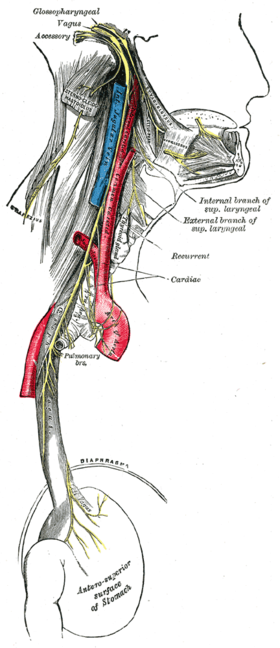Vagotomy
| Vagotomy | |
|---|---|
 Course and distribution of the glossopharyngeal, vagus, and accessory nerves. | |
| ICD-9-CM | 44.0 |
| MeSH | D014628 |
A vagotomy is a surgical procedure that involves removing part of the vagus nerve. It is performed in the abdomen.
Types
A plain vagotomy eliminates the
Highly selective vagotomy refers to denervation of only those branches supplying the lower esophagus and stomach (leaving the nerve of Latarjet in place to ensure the emptying function of the stomach remains intact). It is one of the treatments of peptic ulcer.
Vagotomy is an essential component of surgical management of peptic (duodenal and gastric) ulcer disease (PUD). Vagotomy was once commonly performed to treat and prevent PUD; however, with the availability of excellent acid secretion control with H2 receptor antagonists, such as cimetidine, ranitidine, and famotidine, and proton pump inhibitors (PPIs), such as pantoprazole, rabeprazole, omeprazole, and lansoprazole, the need for surgical management of peptic ulcer disease has greatly decreased.[2]
The basic types of vagotomy are:
- Truncal vagotomy (TV) includes division of the main trunk of the vagus (including its celiac/hepatic branch) and denervation of the pylorus; therefore, a pyloric drainage procedure, such as pyloric dilatation or disruption (pyloromyotomy or pyloroplasty) or gastrojejunostomy, is needed. This procedure also denervates the liver, biliary tree, pancreas, and small and large bowel.[2]
- Highly selective vagotomy includes denervation of only the fundus and body (parietal cell-containing areas) of the stomach (also called parietal cell vagotomy). It preserves the nerve supply of the antrum and pylorus; a pyloric drainage procedure is not needed. It does not denervate the liver, biliary tree, pancreas, or small and large bowel. This procedure is also called proximal gastric vagotomy.[3]
All types of vagotomy can be performed at open surgery (laparotomy) or using minimally invasive surgery (laparoscopy).
For the management of PUD, vagotomy is sometimes combined with antrectomy (removal of the distal half of the stomach) to reduce the rate of recurrence. Reconstruction is performed with gastroduodenostomy (Billroth I) or gastrojejunostomy (Billroth II). It is left intact in highly selective vagotomy so the function of gastric emptying remains intact.[4]
Applications
Truncal vagotomy is a treatment option for chronic duodenal ulcers.
In 2007 the use of vagotomy to treat
History
Vagotomy was once popular as a way of treating and preventing PUD
References
- PMID 8092897.
- ^ PMID 30252360, retrieved 2021-05-06
- ^ "Highly Selective Vagotomy - an overview | ScienceDirect Topics". www.sciencedirect.com. Retrieved 2021-05-06.
- ^ Surgical Treatment of Perforated Peptic Ulcer at eMedicine
- PMID 12625684.
- PMID 11438277.
- PMID 15630940.
- PMID 8678208.
- ^ "Could nerve-snipping spur weight loss? - USATODAY.com". USA Today. 2007-07-02. Retrieved 2010-05-27.
- ^ PMID 12788859.
- PMID 14744442.
- ISBN 0-7216-3256-4.
- PMID 22654817.
- PMID 14525914.
- )
- PMID 6422569.
- PMID 7114938.
- PMID 3401061.
- ^ "Home". pernicious-anaemia-society.org.
External links
- Vagotomy at the U.S. National Library of Medicine Medical Subject Headings (MeSH)
- 00934 at CHORUS
